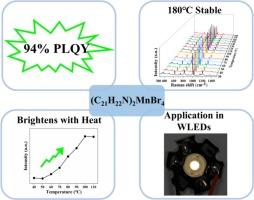Highly efficient photoluminescence and excellent stability in hybrid manganese halides: (C21H22N)2MnBr4
IF 4.6
2区 化学
Q1 SPECTROSCOPY
Spectrochimica Acta Part A: Molecular and Biomolecular Spectroscopy
Pub Date : 2025-10-02
DOI:10.1016/j.saa.2025.126975
引用次数: 0
Abstract
Manganese-based organic-inorganic hybrid metal halides (Mn-based OIHMHs) have attracted much attention due to their low toxicity, abundant resources and unique optical properties. However, the low photoluminescence quantum yield (PLQY) caused by structural factors and non-radiative recombination caused by high temperature have limited their applications. In this study, a green-emitting organic-inorganic hybrid metal halide, (C21H22N)2MnBr4 (C21H22N+ = protonated triphenylamine cation), was designed and synthesized to address these issues. This material has a PLQY as high as 94 %. The main reason is that the longer distance between Mn2+ ions in the (C21H22N)2MnBr4 crystal structure significantly reduces the electron coupling between adjacent Mn centers, thereby inhibiting the non-radiative energy transfer process and thus increasing the PLQY. Additionally, this material exhibits a unique property of increasing luminescence intensity with rising temperature in the range of 40–110 °C, and it has sufficient thermal stability (<180 °C). This breaks the limitation of high-temperature applications. The white light-emitting diodes (WLEDs) fabricated based on this compound feature stable color coordinates and color temperatures, high luminous efficiency, and excellent color rendering index (CRI). Importantly, in comparison to conventional devices, the WLED demonstrates markedly enhanced thermal stability, effectively addressing the issue of efficiency degradation at elevated temperatures that is commonly observed in traditional devices. These advantageous properties render this material system particularly promising for application domains where stringent performance criteria are required for white-light illumination technologies.

杂化卤化锰(C21H22N)2MnBr4的高效光致发光和优异的稳定性
锰基有机-无机杂化金属卤化物(Mn-based OIHMHs)因其低毒性、资源丰富和独特的光学性质而受到广泛关注。然而,结构因素导致的低光致发光量子产率(PLQY)和高温引起的非辐射复合限制了它们的应用。为了解决这些问题,本研究设计并合成了一种绿色发光的有机-无机杂化金属卤化物(C21H22N)2MnBr4 (C21H22N+ =质子化三苯胺阳离子)。这种材料的PLQY高达94%。主要原因是(C21H22N)2MnBr4晶体结构中Mn2+离子之间较长的距离显著降低了相邻Mn中心之间的电子耦合,从而抑制了非辐射能量传递过程,从而增加了PLQY。此外,该材料在40-110℃范围内具有发光强度随温度升高而增加的独特特性,并具有足够的热稳定性(<180℃)。这打破了高温应用的限制。基于该化合物制备的白光二极管具有色坐标稳定、色温稳定、发光效率高、显色指数优异等特点。重要的是,与传统器件相比,WLED显示出显著增强的热稳定性,有效地解决了传统器件在高温下普遍存在的效率下降问题。这些有利的特性使得这种材料系统在白光照明技术需要严格性能标准的应用领域特别有前景。
本文章由计算机程序翻译,如有差异,请以英文原文为准。
求助全文
约1分钟内获得全文
求助全文
来源期刊
CiteScore
8.40
自引率
11.40%
发文量
1364
审稿时长
40 days
期刊介绍:
Spectrochimica Acta, Part A: Molecular and Biomolecular Spectroscopy (SAA) is an interdisciplinary journal which spans from basic to applied aspects of optical spectroscopy in chemistry, medicine, biology, and materials science.
The journal publishes original scientific papers that feature high-quality spectroscopic data and analysis. From the broad range of optical spectroscopies, the emphasis is on electronic, vibrational or rotational spectra of molecules, rather than on spectroscopy based on magnetic moments.
Criteria for publication in SAA are novelty, uniqueness, and outstanding quality. Routine applications of spectroscopic techniques and computational methods are not appropriate.
Topics of particular interest of Spectrochimica Acta Part A include, but are not limited to:
Spectroscopy and dynamics of bioanalytical, biomedical, environmental, and atmospheric sciences,
Novel experimental techniques or instrumentation for molecular spectroscopy,
Novel theoretical and computational methods,
Novel applications in photochemistry and photobiology,
Novel interpretational approaches as well as advances in data analysis based on electronic or vibrational spectroscopy.

 求助内容:
求助内容: 应助结果提醒方式:
应助结果提醒方式:


